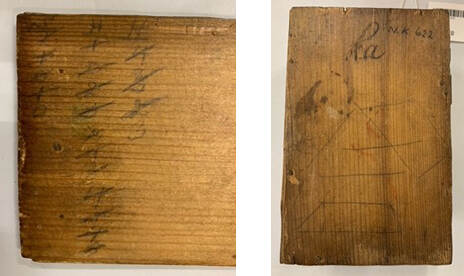In Pursuit of Provenance: unknown wooden box
Weblog
Do you know anything more about the provenance of this box? Every month the In Pursuit of Provenance blog discusses objects from the Netherlands Art Heritage Collection (NK Collection) on which provenance research is being carried out. This collection, among other things, comprises objects that were recovered to the Netherlands after World War II. These objects include paintings and works on paper, as well as furniture and ceramics. By giving a major boost to the research we hope to find new provenance details. This month we are looking at a painted pinewood casket or box.

The box
This box or casket is small: it is only 9.5 cm high, 17.7 cm wide and 11.6 cm deep. It is made from pinewood and can be opened with a rectangular sliding lid. The sides of the box are all painted in a green and red floral motif. A similar box in the collection of the Netherlands Open Air Museum (Nederlands Openluchtmuseum) is described as a Marker box, in reference to the place, Marken, where it was made. That may also apply to this box. It is unknown what the box was used for, when it was made or by whom.

The research
Nothing is known about the provenance of this box. We do not know who owned it during World War II, how the box came to be in Germany and by what route it was returned to the Netherlands after the war.
After archive research came to a dead end due to a lack of leads, the box was physically examined for clues. When the object was examined, pencil marks were found. There are three letters on the underside of the lid, with a series of crossed-through numbers underneath. Perhaps this was a way of keeping score in a game, for example. The letters could stand for the names of the people who played the game.
Letters were found on the underside of the box too: ‘Ka’ or possibly ‘La’. We have no idea what this could be referring to. Two drawings can also be seen that appear to illustrate a house or roof.
All in all, very little is known or can be said with any certainty about this box. Do the inscriptions found indicate its use as a box for a game, or did it serve another purpose? It is, in any event, clear that this box was used. The question remains: by whom? Can you tell us anything more about the use of this box or its origins? If so, please let us know!
Can you help us?
A team of provenance researchers at the Cultural Heritage Agency of the Netherlands (RCE) is working on renewed and additional provenance research on objects held in the NK Collection (The Netherlands Art Heritage Collection). Part of their work is to make the research results accessible online and to extract relevant information and data in a sustainable manner. This targeted approach gives us a clearer picture of the objects. Do you have any further information about the provenance of this casket or box (NK622)? If so, please contact us via restitutie@cultureelerfgoed.nl.
This blog was written by Simone van Wijk, provenance researcher at the RCE.